What’s more fun than spending time by yourself on long hikes and in the mountains? Spending time there with a canine companion! Dogs are perfect partners for outdoor adventures: Always happy, always excited and ready to go anywhere you want. But not all breeds make the perfect hiking dogs. If you are an avid hiker looking for a companion, this article lays out the best hiking dog breeds by size, and also, what other considerations you should have when choosing a hiking dog.
The Importance Of Breed
Your dog will be your companion for 15 years. It is crucially important to pick a breed that fits your lifestyle and expectations. In my daily work as a dog trainer, 50% of all problem cases that I see could have been prevented if the owners had chosen a breed that better fits their lifestyle.
While it is tempting to rush off and get a puppy right away, putting some time into choosing the right one will pay off many times in the future.
There are over 300 dog breeds recognized by the FCI (the biggest international breed club) currently – there’s a dog for everyone out there, you just have to find your perfect match.
Purebred Vs Mixed Breed
The actual breed may not be as important as the traits that that breed inherits. There are thousands of mixed breeds that would make incredible hiking dogs, as well as dozens of purebreds. Below, we highlight the best purebred breeds, but you can also look for mixed breeds that have the characteristics listed below.
Hiking Dog Traits
When looking for hiking dogs specifically, you want to consider the following aspects.
Athleticism
Sure, every dog likes to go for a walk around the block once a day. But hiking for hours over uneven terrain and in potentially high altitudes is a different story. There are many sedentary dog breeds such as Pugs, Bulldogs or Mastiffs for whom this is neither fun nor healthy.
You need to pick a breed that was bred for strength and endurance.
Coat Type
When you go backpacking, you probably do not want to take a suitcase full of grooming supplies along. A dog breed such as the Afghan Hound with thick, floor-length hair that requires daily extensive brushing will not be a good choice for a hiking companion.
However, this does not mean that every long-coated dog is out of the picture – a lot of long-haired dogs actually have very low-maintenance coats that only require brushing once a week.
In addition, if you are in a warm climate, or a cold climate, you need to think about the breed that can handle common temperatures of that area. For example, a huskie is likely not a great choice for someone that lives in Florida.
Healthy Parents
Even in generally healthy pure-bred dogs there can be breed-specific health problems. This is why it is very important to check that the parents of the puppy you pick out have been specifically screened for these issues.
Breed-specific health issues can range from elbow and hip dysplasia over heart conditions to epilepsy and vision or hearing problems.
When looking for a puppy, inquire whether the breeder has tested the parents. Depending on the condition, there are a variety of tests – from x-rays for skeletal problems over blood tests for genetic markers to hearing and vision examinations.
Trainability
You likely should be looking for breeds and combinations that indicate this dog is trainable, and willing to learn. The easier a dog is to train, the better. This doesn’t always necessarily mean smarter, but smarter breeds can often be trained quicker.
The Best Hiking Dog Breeds – Organized By Size
Large Breeds
German Shorthair Pointers
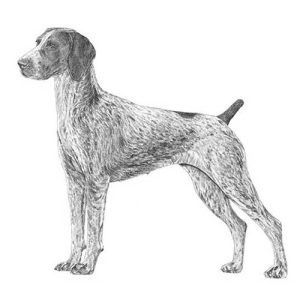 These hunting dogs love nothing as much as running for hours. While less active owners often struggle with keeping these dogs as pets due to their endless energy, hikers and backpackers will find perfect companions in German Shorthair Pointers. They are incredibly friendly dogs who will be glad to meet any human or canine who comes across their path. Aggression is not a common problem in this breed!
These hunting dogs love nothing as much as running for hours. While less active owners often struggle with keeping these dogs as pets due to their endless energy, hikers and backpackers will find perfect companions in German Shorthair Pointers. They are incredibly friendly dogs who will be glad to meet any human or canine who comes across their path. Aggression is not a common problem in this breed!
Start training your German Shorthair Pointer early and teach him to stay by your side. These dogs are prone to be bad leash pullers if not taught to walk nicely from a young age.
| Height | 23-25 inches (male) | 21-23 inches (female) |
|---|---|
| Weight | 55-70 pounds (male) | 45-60 pounds (female) |
| Life Expectancy | 10-12 Years |
Golden Retrievers
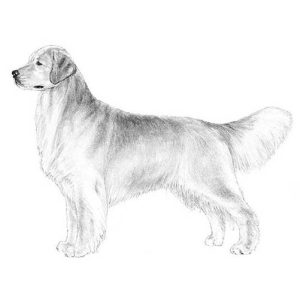 Known as the classic family dog, Golden Retrievers do not need to be couch potatoes. Originally a dog breed developed for hunting, they still have a lot of energy and will be more than happy to follow along on your hikes. Goldens love water – it will be a difficult task to keep them out of any spring, lake or stream you come across. They are typically very good about coming when called and do not show a lot of interest in chasing wildlife.
Known as the classic family dog, Golden Retrievers do not need to be couch potatoes. Originally a dog breed developed for hunting, they still have a lot of energy and will be more than happy to follow along on your hikes. Goldens love water – it will be a difficult task to keep them out of any spring, lake or stream you come across. They are typically very good about coming when called and do not show a lot of interest in chasing wildlife.
When choosing a Golden as a hiking companion, make sure to ask for the parents’ hip status. Hip dysplasia is unfortunately common in the breed (it can easily be diagnosed through x-ray), so you should only choose a puppy from parents with good hips.
| Height | 23-24 inches (male) | 21.5-22.5 inches (female) |
|---|---|
| Weight | 65-75 pounds (male) | 55-65 pounds (female) |
| Life Expectancy | 10-12 Years |
Huskies
Being sled-dogs, Huskies were bred for one ultimate purpose: To run!
Many dog owners struggle with burning off all the steam and energy these dogs have. They can be highly destructive and are notorious for finding a way out of the yard and running away when left unsupervised.
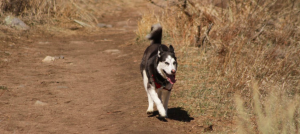
Huskie Hiking
While Huskies are not a good choice for most “average dog owners”, as a hiker these dogs will easily go stride for stride with you.
Huskies have unlimited energy and wish to run. Many hikers who own Huskies tie them up with a waist belt and get an extra boost on the way up the mountain, while the dogs get an extra workout.
Huskies tend to have very poor recalls (they prefer to come on their own terms), so you will probably need to keep your Huskie on a leash every time you go for a hike.
| Height | 21-23.5 inches (male) | 20-22 inches (female) |
|---|---|
| Weight | 45-60 pounds (male) | 35-50 pounds (female) |
| Life Expectancy | 12-14 Years |
Medium Sized Dogs
Australian Cattle Dogs (“Heelers”)
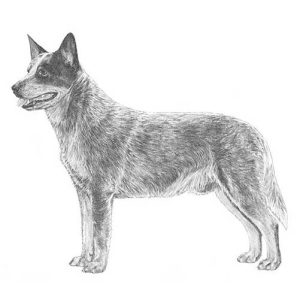 Cattle Dogs are perfect hiking companions. They were originally bred to herd cattle over difficult terrain in Australia. Looking at that history, it is no wonder that Heelers have unlimited endurance and are very tough dogs. You won’t find a Heeler quitting on you before you have reached your goal for the day. They are happy to hike in all terrain and in all weather. As a breed, Heelers are very healthy and require no grooming. The only aspect to pay attention to is their tendency to nip – it is important that they are trained with positive methods to not bite ankles of any fellow hikers, as this will get old quickly.
Cattle Dogs are perfect hiking companions. They were originally bred to herd cattle over difficult terrain in Australia. Looking at that history, it is no wonder that Heelers have unlimited endurance and are very tough dogs. You won’t find a Heeler quitting on you before you have reached your goal for the day. They are happy to hike in all terrain and in all weather. As a breed, Heelers are very healthy and require no grooming. The only aspect to pay attention to is their tendency to nip – it is important that they are trained with positive methods to not bite ankles of any fellow hikers, as this will get old quickly.
| Height | 18-20 inches (male) | 17-19 inches (female) |
|---|---|
| Weight | 35-50 pounds |
| Life Expectancy | 12-16 Years |
Border Collies
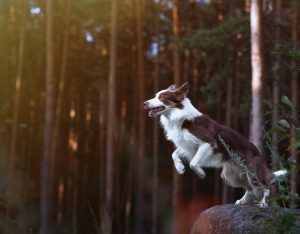
Another dog breed from the herding family, Border Collies are also ready to hike by your side all day long. Compared to Heelers they are a lot more gentle and soft in their character. Border Collies have less tendency to nip. They will however try and herd anything and everything in their way. While Border Collies rarely run off and listen very well to recalls, many hikers have experienced that they certainly have to put their dog on a leash when they come by a field with cattle, or otherwise the dog will help himself to some herding work.
Border Collies are known for their long, black-and-white coat; but they do in fact come in a large variety of colors and coat types. They can have a short coat, as well as be brown, golden or merle-colored.
| Height | 19-22 inches (male) | 18-21 inches (female) |
|---|---|
| Weight | 30-55 pounds |
| Life Expectancy | 12-15 Years |
Nova Scotia Duck Tolling Retriever (“Tollers”)
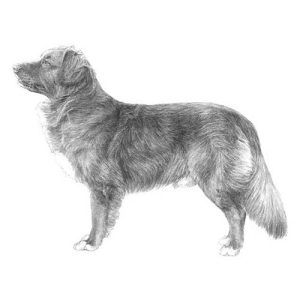 Tollers look like the little cousin of the Golden Retriever, and that is exactly what they are. As intelligent and affectionate workaholics, like many other breeds on our list they are not a dog for someone who likes to sit back on the couch on the weekend.
Tollers look like the little cousin of the Golden Retriever, and that is exactly what they are. As intelligent and affectionate workaholics, like many other breeds on our list they are not a dog for someone who likes to sit back on the couch on the weekend.
Tollers are very healthy as a breed, and rarely show any behavioral problems. They will be happy to go wherever you go, and do whatever you do. Tollers have a characteristic “scream”, that can be heard when they are excited and ready to go. If you have close neighbors, you might rethink getting a Toller. For long weekends out in the wilderness however, there cannot be a better partner.
| Height | 18-21 inches (male) | 17-20 inches (female) |
|---|---|
| Weight | 35-50 pounds |
| Life Expectancy | 12-14 Years |
Small Dogs
Parson Russell Terrier
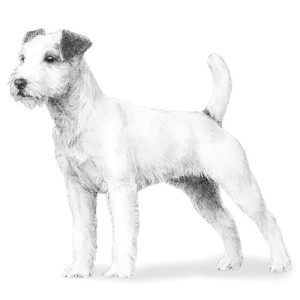 If you are looking for a smaller companion, the Terrier family has a lot of very active dogs that will love to come on long hikes with you.
If you are looking for a smaller companion, the Terrier family has a lot of very active dogs that will love to come on long hikes with you.
The Parson Russell Terrier is a less-known Terrier who is becoming more and more popular in dog sport circles. At only around 15lbs these little guys have a whole lot of energy and will to go.
Terriers are no lap dogs – they were originally bred to hunt vermin and crawl into the dens of foxes. No wonder they’re tough as nails and don’t give up – ever!
Like already with the German Shorthair Pointer, you want to start training early, so that your Terrier stays by your side instead of running off into each burrow he sees.
| Height | 14 inches (male) | 13 inches (female) |
|---|---|
| Weight | 13-17 pounds |
| Life Expectancy | 13-15 Years |
Pyrenean Shepherd
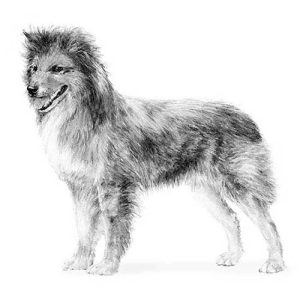 No – not a Great Pyrenees – but his much smaller counterpart, also from the French Alps! These little herding dogs have amazing endurance, astonishing climbing skills and love nothing as much as being with their owner. Pyrenean Shepherds are a very healthy breed with an easy-to-care-for, medium-length coat. They are definite on-person dogs: Once they have decided who “their human” is, nobody else is interesting to them!
No – not a Great Pyrenees – but his much smaller counterpart, also from the French Alps! These little herding dogs have amazing endurance, astonishing climbing skills and love nothing as much as being with their owner. Pyrenean Shepherds are a very healthy breed with an easy-to-care-for, medium-length coat. They are definite on-person dogs: Once they have decided who “their human” is, nobody else is interesting to them!
Pyrenean Shepherds are very high energy dogs (in fact, their breed standard itself calls for “nervous energy”) and are only a good choice if you are a truly active person. They can show some reactivity towards other dogs, so definitely make sure to expose them and give them positive experiences during their puppyhood.
| Height | 15.5-18.5 inches (male rough-faced) 15-18 inches (female rough-faced) 15.5-21 inches (male smooth-faced) 15.5-20.5 inches (female smooth-faced) |
|---|---|
| Weight | 15-30 pounds |
| Life Expectancy | 17-19 Years |
Miniature Poodle
 Poodles are known first and foremost for their presence in the showring and elaborate hairdos. This does their intelligence and athleticism a great disservice, though!
Poodles are known first and foremost for their presence in the showring and elaborate hairdos. This does their intelligence and athleticism a great disservice, though!
Standard Poodles were originally bred as waterdogs – this is where their characteristic coat stems from. Because they were so popular, breeders developed their smaller counterparts: the Miniature and the Toy Poodle.
These little ones come equipped with the same amount of energy and intelligence. A Poodle seems to flow when he is running and will happily cover many miles with you in a day. Their coat is not as work-intense as it may seem: Many owners keep their Poodles shaved down in what is called a “sport cut”, which makes their coat just as easy to care for as any short-coated breed. Plus, they do not shed – so you can share your tent and sleeping bag without having any dog hair stuck to it.
| Height | 10-15 inches
|
|---|---|
| Weight | 10-15 pounds |
| Life Expectancy | 10-18 Years |
Breeds To Avoid
There are many breeds that commonly have health problems, or traits that don’t make them great hiking dogs.
For example, english bulldogs, pugs, mastiffs, pekingese, and others tend to have traits that make it difficult for them to hike for extended periods of time. Some larger breeds like great danes, newfoundlands, saint bernards, and others are prone to hip problems that can potentially make them unable to hike long distances.
Keep this in mind when choosing a hiking dog, but also note that some of these dogs still can be incredible trail dogs, as these are generalizations, and some individual dogs can certainly excel!
Learn More About Each Breed
The above breeds are a great starting point to look into. For more detailed information on each breed, habits, trainability, and more, be sure to check out the American Kennel Club.
Steffi Trott is an avid hiker from New Mexico who often travels to Colorado for backpacking trips. During the day, she is a professional dog trainer who has helped many owners bring out the best companions in their canine counterparts. She is originally from Europe and has hiked all over the Alps, especially the Dolomites.
